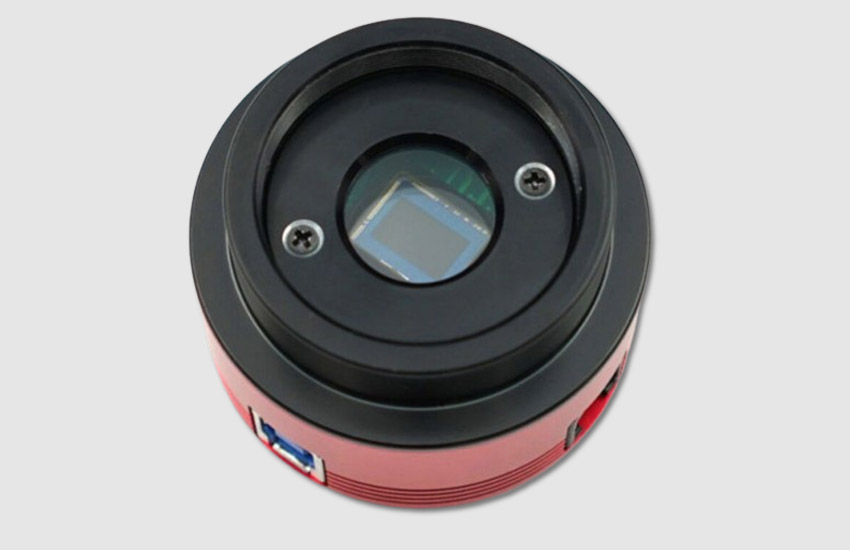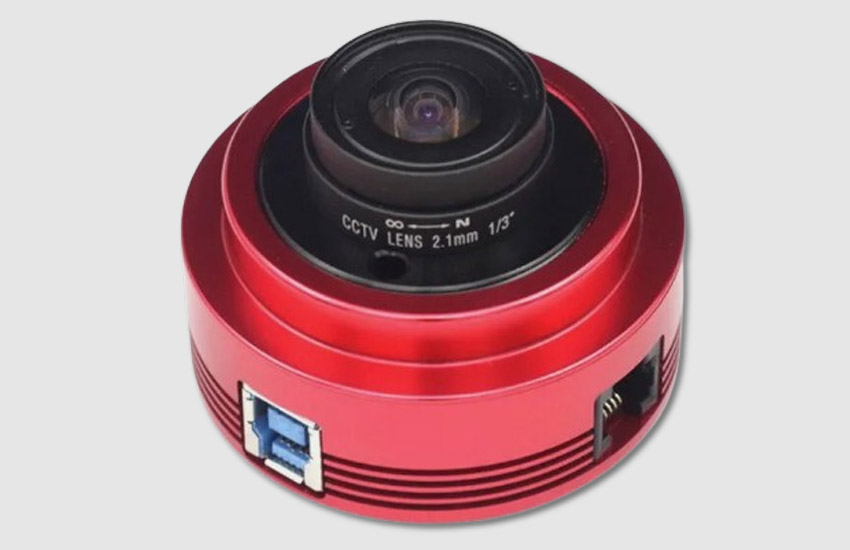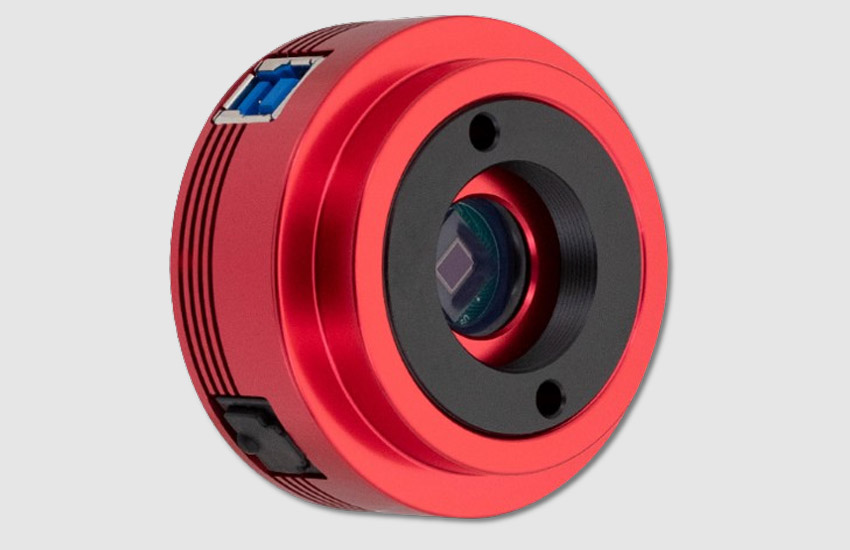The ZWO ASI120MM-S Astronomy Camera is a compact yet powerful monochrome camera designed specifically for astrophotography enthusiasts. Whether you’re capturing stunning planetary images or guiding your telescope for long-exposure imaging, this camera offers impressive features that make it a valuable addition to your equipment lineup.It is a versatile and affordable monochrome camera designed for planetary and lunar imaging. Let’s explore why the ASI120MM-S stands out in the world of amateur astronomy.
Our Top Pick
No products found.
Key Features
Advanced CMOS Sensor Technology
1/3” CMOS Monochrome Sensor
The ZWO ASI120MM-S is equipped with a 1/3” CMOS monochrome sensor (MT9M034), which offers a resolution of 1280 x 960 pixels with a pixel size of 3.75 µm. This sensor is renowned for its high sensitivity and low noise levels, making it ideal for astrophotography. The monochrome sensor provides greater detail and clarity compared to color sensors, as it captures more light and does not suffer from the light loss associated with color filters.
High Sensitivity and Low Noise
One of the standout features of the ASI120MM-S is its high sensitivity and low noise. With a peak Quantum Efficiency (QE) of 75%, this camera can capture faint details with shorter exposure times, reducing the overall noise in the images. The low read noise, coupled with the high sensitivity, ensures that the camera can capture clear and detailed images of various celestial objects.
Connectivity and Compatibility
USB 3.0 Port
The ZWO ASI120MM-S features a USB 3.0 port, which ensures fast data transfer rates. This capability allows the camera to operate at 60 frames per second (fps) at full resolution, and even higher frame rates at lower resolutions. The high-speed data transfer is crucial for capturing rapid sequences of images, which is essential for planetary imaging.
ST4 Guide Port
The inclusion of an ST4 guide port makes the ASI120MM-S compatible with autoguiding systems. This feature is particularly useful for deep-sky imaging, where precise tracking is necessary for long-exposure shots. The ST4 port allows the camera to connect directly to the autoguider port on a mount, providing seamless integration and improved tracking accuracy.
Design and Build Quality
Compact and Lightweight Design
The ASI120MM-S is designed to be compact and lightweight, making it easy to transport and set up. Its small form factor ensures that it can be used with a variety of telescope setups without adding significant weight or requiring extensive modifications.
Durable Construction
Constructed with high-quality CNC machined aluminum, the ASI120MM-S is built to withstand the rigors of regular use. Its robust design ensures that it can handle various environmental conditions, making it a reliable choice for astrophotographers who often set up in remote or outdoor locations.
Performance Analysis

Image Quality
High Dynamic Range
The high dynamic range of the ASI120MM-S results in detailed and clear images. The camera can capture a wide range of light intensities, preserving both the bright and faint details in a single shot. This feature is particularly beneficial for astrophotography, where capturing the subtle details of celestial objects is crucial.
Low Read Noise
The camera’s low read noise is a significant advantage, particularly for long-exposure imaging. Low read noise ensures that the images captured are clear and free from unwanted artifacts, providing a clean and sharp representation of celestial objects.
Usability
Software Compatibility
The ZWO ASI120MM-S is compatible with a wide range of astrophotography software, including popular programs like SharpCap, FireCapture, and PHD2. This broad compatibility ensures that users can integrate the camera into their existing workflows with ease, leveraging the advanced features of these software tools to enhance their imaging sessions.
User-Friendly Operation
Designed with both beginners and advanced users in mind, the ASI120MM-S offers a user-friendly operation. The straightforward setup process and intuitive controls make it accessible to newcomers, while the advanced features and performance satisfy the needs of experienced astrophotographers.
Use Cases
Planetary Imaging
Capturing Planets
The ASI120MM-S excels in planetary imaging, thanks to its high resolution and fast frame rates. By capturing multiple frames per second, astrophotographers can use stacking techniques to combine the best frames, reducing atmospheric distortion and enhancing the final image quality. This approach is particularly effective for capturing detailed features of planets like Jupiter’s Great Red Spot or the rings of Saturn.
Lunar Photography
The camera’s high sensitivity and resolution also make it ideal for lunar photography. The ASI120MM-S can capture intricate details of the lunar surface, including craters, mountain ranges, and maria. The ability to capture high-speed sequences helps to mitigate the effects of atmospheric turbulence, resulting in sharp and clear images.
Deep-Sky Object Imaging

Long-Exposure Capabilities
While primarily designed for planetary imaging, the ASI120MM-S is also capable of capturing deep-sky objects. By using long exposures and stacking multiple images, astrophotographers can capture the faint details of galaxies, nebulae, and star clusters. The camera’s low noise levels and high sensitivity make it well-suited for this type of imaging.
Integration with Other Equipment
The ASI120MM-S can be easily integrated with other astrophotography equipment, such as filters, filter wheels, and off-axis guiders. This flexibility allows users to enhance their imaging capabilities and achieve even better results. For example, using narrowband filters can help isolate specific wavelengths of light, improving the visibility of certain features in deep-sky objects.
Additional Features
Advanced Features
Amp-Glow Reduction Technology
The ASI120MM-S incorporates amp-glow reduction technology, which is crucial for long-exposure imaging. Amp-glow is a common issue in CMOS sensors that can degrade image quality, particularly during extended exposures. The built-in technology reduces this effect, ensuring cleaner and more consistent images.
Cooling System
Although the ASI120MM-S does not have active cooling, its design includes natural convection cooling, which helps manage the sensor’s temperature. Keeping the sensor cool reduces thermal noise, which is essential for achieving high-quality images, especially in longer exposure scenarios.
Accessories and Add-Ons
Included Accessories
The camera comes with several useful accessories, including a USB cable, ST4 guide cable, and adapters. These accessories ensure that users have everything they need to start imaging right away, making the setup process smoother and more efficient.
Optional Add-Ons
There are various optional add-ons available for the ASI120MM-S, such as different types of filters and filter wheels. These add-ons can enhance the camera’s performance and versatility, allowing users to tailor their setup to specific imaging needs. For example, using a UV/IR cut filter can improve image sharpness and color accuracy.
Maintenance and Best Practices

Regular Maintenance
Cleaning and Storage Tips
To maintain the performance of the ASI120MM-S, it is important to clean the sensor and optical surfaces regularly. Use a soft, lint-free cloth and appropriate cleaning solutions to remove dust and smudges. When not in use, store the camera in a protective case to prevent damage and exposure to dust and moisture.
Software Updates
Keeping the camera’s software and drivers up to date is essential for optimal performance. Regularly check for updates from ZWO and install them to ensure that the camera functions smoothly and benefits from any improvements or new features.
Troubleshooting Common Issues
Common Problems and Solutions
Like any advanced piece of equipment, the ASI120MM-S may encounter occasional issues. Common problems include connectivity issues, software glitches, and image artifacts. Refer to the user manual and online forums for troubleshooting tips, and contact ZWO support for assistance if needed. Ensuring that all cables are securely connected and that the software is correctly configured can often resolve most issues.
ZWO ASI120MM-S Monochrome Astronomy Camera
Unlock the cosmos with this powerful monochrome camera.
Comparison with Competitors
ZWO ASI120MM-S vs. ZWO ASI290MM
Sensor Differences
The ZWO ASI120MM-S and ASI290MM both use CMOS sensors but differ in their specifications. The ASI290MM features a larger sensor and higher resolution, which can be advantageous for certain types of imaging. However, the ASI120MM-S’s lower noise levels and high sensitivity make it a strong competitor, particularly for planetary imaging.
User Experience
Both cameras offer excellent performance, but the ASI120MM-S is often preferred for its ease of use and compatibility with a wide range of software. The ASI290MM, with its higher resolution, is favored by those who need more detailed images and are willing to manage the slightly more complex setup.
ZWO ASI120MM-S vs. SVBONY SV305 Pro
Price vs. Performance
The SVBONY SV305 Pro is a more budget-friendly option, but the ZWO ASI120MM-S often outperforms it in terms of sensitivity and noise levels. The ASI120MM-S’s advanced sensor technology and robust build quality justify its higher price point, offering better overall performance for serious astrophotographers.
Feature Set Comparison
While both cameras are capable of high-quality imaging, the ASI120MM-S’s additional features, such as amp-glow reduction and superior software compatibility, make it a more versatile and reliable choice. The SV305 Pro is a good option for beginners or those on a budget, but the ASI120MM-S offers more advanced capabilities for serious astrophotographers.
Conclusion
The ZWO ASI120MM-S strikes a balance between affordability and performance. Whether you’re guiding your telescope or capturing stunning planetary images, this camera won’t disappoint. Its compact design, low noise, and USB 3.0 connectivity make it a valuable addition to any astrophotography setup.
Frequently Asked Questions (FAQs)
What are the optimal settings for planetary imaging?
For planetary imaging, it is recommended to use high frame rates, short exposure times, and a gain setting that balances sensitivity with noise. Software like SharpCap or FireCapture can be used to fine-tune these settings. Additionally, using a Region of Interest (ROI) can help increase the frame rate by capturing only the relevant portion of the sensor. Stacking multiple exposures using tools like RegiStax or AutoStakkert can further enhance image quality by reducing atmospheric distortion.
Is the ZWO ASI120MM-S suitable for deep-sky imaging?
Yes, the ZWO ASI120MM-S is suitable for deep-sky imaging. Although it is primarily designed for planetary imaging, its high sensitivity and low noise levels make it capable of capturing faint details of galaxies, nebulae, and star clusters. Long exposure capabilities up to 1000 seconds allow astrophotographers to capture the necessary light from deep-sky objects. Using stacking techniques and appropriate filters can further enhance the quality of deep-sky images.
How do I connect the camera to my telescope?
The ZWO ASI120MM-S can be connected to a telescope using standard 1.25″ or 2″ adapters. The camera comes with a 1.25″ nosepiece and a M42x0.75 adapter, making it compatible with most telescope focusers. Ensure that the camera is securely attached and that all connections are tight to avoid any movement during imaging. Connect the USB 3.0 port to a computer for data transfer, and the ST4 guide port to an autoguider port on the mount if autoguiding is used.
What software is recommended for this camera?
The ZWO ASI120MM-S is compatible with a wide range of astrophotography software, including SharpCap, FireCapture, and PHD2. These programs offer features for capturing, processing, and analyzing images, making them essential tools for astrophotographers. ZWO’s own software, ASIStudio, is also a good option for managing and processing images from the ASI120MM-S. Additionally, software like RegiStax and AutoStakkert can be used for stacking and enhancing captured images.
Can this camera be used for autoguiding?
Yes, the ZWO ASI120MM-S is equipped with an ST4 guide port, making it suitable for autoguiding. It can be connected to an autoguider port on the mount, and software such as PHD2 can be used to manage the guiding process. The camera’s high sensitivity and low noise make it effective for detecting and tracking guide stars, ensuring precise tracking during long exposure imaging sessions.
What are the advantages of using a monochrome camera for astrophotography?
Monochrome cameras, like the ZWO ASI120MM-S, offer several advantages for astrophotography. They are more sensitive than color cameras because they do not have a Bayer matrix that filters the light. This increased sensitivity allows for capturing finer details and more light in a given exposure time. Additionally, monochrome cameras can be used with various filters (such as LRGB or narrowband filters) to capture different wavelengths of light, which can be combined to create high-quality, detailed images with enhanced contrast and color accuracy.
How does the USB 3.0 port improve performance?
The USB 3.0 port on the ZWO ASI120MM-S allows for significantly faster data transfer rates compared to USB 2.0. This increased speed enables the camera to capture higher frame rates, which is crucial for planetary imaging. For example, the ASI120MM-S can achieve up to 60 frames per second (fps) at full resolution and even higher frame rates at lower resolutions. This capability allows astrophotographers to capture rapid sequences of images, which can be stacked to improve image quality and reduce the effects of atmospheric turbulence.
What accessories are included with the ZWO ASI120MM-S?
The ZWO ASI120MM-S comes with several useful accessories to help you get started right away. These include a USB 3.0 cable for fast data transfer, an ST4 guide cable for autoguiding, a 1.25″ nosepiece, and a M42x0.75 adapter for connecting to different telescope focusers. The package also includes a software CD with drivers and popular astrophotography software such as SharpCap, FireCapture, and ASIStudio.
How do I maintain and clean the ZWO ASI120MM-S?
To maintain the performance of the ASI120MM-S, it is important to clean the sensor and optical surfaces regularly. Use a soft, lint-free cloth and appropriate cleaning solutions to remove dust and smudges. When not in use, store the camera in a protective case to prevent damage and exposure to dust and moisture. Additionally, keep the software and drivers up to date by regularly checking for updates from ZWO.
What should I do if I encounter issues with the camera?
If you encounter issues with the ZWO ASI120MM-S, first refer to the user manual and online forums for troubleshooting tips. Common problems include connectivity issues, software glitches, and image artifacts. Ensure that all cables are securely connected and that the software is correctly configured. If the issue persists, contact ZWO support for assistance. They can provide guidance and help resolve any technical problems you may encounter.




